THE TREME BONE’S CONNECTED TO THE — RIO BONE….
Although Mardi Gras season tends to run late into the night, Mardi Gras day itself is much like Christmas–the excitement begins at the crack of dawn (or earlier), with the festivities already ebbing by late afternoon. Yes, some people rage on until midnight, just as some cling to Christmas till the waning hours, but the last parade wraps up in the early afternoon, prompting the feasts and reunions in the neutral ground to gradually clear. Soon the roads are largely deserted except for Bourbon, Frenchman, and (allegedly) those surrounding the Backstreet Cultural Museum in Treme. I’m sure a few other spots continue to thrive, but generally celebration tends to move to house parties and bars.
Thus I had my alarm set for six in the morning to get an early start. Instead, I turned it off and went back to sleep.
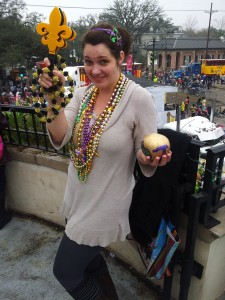
The Early Bird Gets The Booty: This lady snagged a hand painted Zulu coconut, one of Mardi Gras’ most coveted throws!
Zulu rolls at 8am Mardi Gras morning and was my favorite parade viewed during my first Mardi Gras, yet I haven’t caught it since. I was dying to see it again, but that would mean a very early start. Even leaving at 7am on what would normally be a fifteen minute drive would be pushing it, considering I’d have to avoid lane closures, dodge floats, and compete for a parking space with half the city’s residents and all of its tourists. Yet I couldn’t move. I was exhausted from my adventures and the cold that was festering in my head and chest was in no way helped by my spending Lundi Gras in the rain. Plus it was going to be a long day. Zulu would have to wait another year.
And, heck, things kickoff before Zulu that I many never be up early enough to observe. I mentioned in my last post the tradition of dressing as skeletons. This originated with the Northside Skull & Bones Gang, a krewe that annually wakes up the Treme neighborhood in the wee hours of Mardi Gras morning, apparently a spectacle to behold. Their masquerading in an oddly celebratory reminder of mortality conjures up images of Rio’s Carnival, Mexico’s Day of the Dead, and Carribean voodoo tradition, illuminating just how rich and diverse the Mardi Gras tradition is. Some day….
OGRES STILL HAVE LAYERS
On the ‘WHAT‘ page, I explain how Mardi Gras is a complex, layered tradition using the Shrek “Ogres are like onions” scene as a metaphor. Because of this complexity and diversity there is no single way to experience it. While tons of people pour into the streets for the parades, some people stay at home and have house parties. Every neighborhood has its own traditions, as does every family. The parades that run from Uptown to the French Quarter, meandering along the way but focusing on St. Charles Avenue and Canal Street, are the highlight for much of the city, though some prefer to go searching for Indians masquerading in either Uptown or Downtown–having no set course, the thrill of the hunt is part of the appeal. There’s music and mayhem in bars across town and of course a party in the Quarter, with Bourbon Street being the tiny epicenter of debauchery that gets tons of press. On the ‘other end’ of Bourbon Street, towards Esplanade, you get ‘Gay Mardi Gras’ which is as much about voyeurism as the tourist side, though here it’s about flamboyance more than flesh (but make no mistake–there’s no lack thereof). Beyond Esplanade lies the Marigny, an up-and-coming hipster, artsy neighborhood centering on Frenchman Street where a small parade of its own has developed. Here, everyone dresses up like they do on Canal and in the Quarter, but Frenchman is filled with bars that focus on local music and thus attracts more locals. (Tourists party on Bourbon; locals and visitors in-the-know party on Frenchman.) And this is by no means an exhaustive list of the choose-your-own adventure that is Mardi Gras. If you’re mobile and alone (like I would be) or in a small group, you can manage to survey quite a swath of these varying celebrations, but no one can experience the infinite combinations of this multi-faceted cultural phenomenon.
Therefore to plan my day for maximum literary immersion, my friend Pat Thompson (another Marquis introduction who has graciously been acting in capacity of culture ambassador for the city) suggested a route that, while requiring a great deal of walking, would provide a grand cross-section of Mardi Gras across the city. Despite my deteriorating health I decided to take his advice, sans one detail: He suggested a big plastic cup with a lid to refill along the way, but I was in no shape to drink. I was embarking on what may very well be the first dry Mardi Gras in history.
JUST LIKE YOUR HIGH SCHOOL GEOGRAPHY CLASS, ONLY WITH BEADS & BEER
View
For my day’s journey to make sense, let me explain New Orleans geography to the unfamiliar. Any understanding of New Orleans begins with the Mississippi River which actually runs eastward, rippling like a roller coaster, throughout much of its final stages in the southern Louisiana peninsula. The oldest neighborhoods of New Orleans sprung up within one of these ripples–a long ‘smile’ with steep eastern and western banks. The French Quarter, which encompases the original city limits (and remains so to the first-time drunken tourists), was laid out on the crescent curve on the northeastern bank of this smile, thus ‘The Crescent City.’ Because of this orientation, this small but central neighborhood (13 blocks wide, 6 deep) is aligned in a near perfect 45 degree NW to SE axis. Canal Street, its southwestern border, is the widest street in town and a major economic thoroughfare running from the river northwest towards the Pontchetrain. St. Charles Avenue, the storied thoroughfare transecting the entire ‘American section’ follows the river’s curve, starting at Canal Street and ending at the western bank where it intersects Carrollton which shoots northwest, intersecting Canal creating a triangle within the ‘smile.’ (Beyond this western bank, the river turns westward forming the southern border of the oft-mention suburb, Metairie.) Just beyond Esplanade, the Quarter’s northeastern border, lies Marigny, which due to the Quarter’s orientation, is another triangular neighborhood. At the edge of Marigny, Frenchman Street intersects with Decatur (the Quarter’s riverfront street), jutting off at a 45 degree angle. Hopefully the above map will help this make sense. I marked all of the borders and streets mentioned.
For today’s route, I would start Uptown on St. Charles near its western end (I marked the spot where I found parking) and catch Rex and the truck parades as they came down Napoleon Avenue and turned down St. Charles. After the parades, I would wander down St. Charles taking in the sights along the way until I reached the French Quarter, where I’d follow Bourbon from Canal to Esplanade in all it’s insanity, then make my way to Frenchman. Though in doubt at times, I actually followed this plan and even tagged on a return to the Quarter to hear music on Decatur and dine on Royal Street before my night was over, though I’d pay dearly the next day.
NEW RESPECT & OLD ATTITUDES
I decided to take the back way into town and it paid off. Though I was slowed by a few floats lining up for the truck parade, I made it to St. Charles relatively easy, driving toward the parades until parking ran out and then turning back to search for a spot. I was meeting Chris and Pam Tusa again, this time at Superior Seafood where they had a spot on the roof to watch as Rex turned from Napoleon Avenue down St. Charles. The walk, a mere ten minute stroll along this storied, tree-lined street where I was accompanied by costumed families pulling kids in wagons, was pleasant despite the threatening weather. I arrived shortly after ten to catch the third float of Rex–not bad considering. It was an overcast day again and continued forecast of showers kept a lot of people away, thus my parking fortune, and found a sparser than expected crowd awaiting me.
New Orleans has a way of sneaking dimes out of our pocket, and I was becoming increasingly economically conscience having burned through quite a wad already. I was, after all, now unemployed. It was only fifteen dollars to get up top, but the street wasn’t crowded, and I easily caught a couple of cups and a medallion within a few minutes, plus there were portalets in the neutral ground (where to pee is THE #1 concern for everyone without home or hotel on the parade routes) so I settled in and texted Chris that I was downstairs. He soon appeared to chat and hang out, but suddenly broke off and dove into the crowd. A tribe of Indians had appeared up Napoleon and were waiting to cross the parade route.
I’ve spoken of Mardi Gras Indians in several places and won’t give the entire history here, though I will reiterate that these tribes originate from African-American neighborhoods, usually impoverished, and were born out of pride and defiance in an era of segregation. For much of New Orleans, an Indian sighting is a sign of luck or at least good fortune. The costumes change every year and are mind-blowingly elaborate. Recent documentaries and the HBO show Treme seem to have gone a long way in finally granting this tradition respect and reverence in the broad landscape of Mardi Gras, but tension between police and Indians still exists because their parading is unlicensed and unsanctioned (i.e. untaxed!), and racial tension and white resentment still thrive in this city where different cultures bump against one another on a daily basis. Such undercurrents revealed themselves as Chris and I rushed as close as we could to snap a fleeting picture. An older couple of obvious means were stuck beside the tribe (where we would have loved to be!) and shooed them across the street like stray dogs as a break in the parade appeared. “They usually don’t come this far Uptown,” she said in disgust.
BEAD DOGS & THE E-TRADE BABY
As we made our way back, Chris soon talked me into buying a ticket. The crowd on the roof–literally, we took a makeshift ladder up–was even more sparse (less than ten people) but I enjoyed socializing even if it was more difficult to attract the attention from the floats up there. As I waved at the passing floats, I chatted with an actress and special education aide who had caught a coconut earlier from Zulu, one of the prizes of carnival season, and a couple who had attended law school at Tulane. Later the bartender, who grew up in town going to parades, took a remnant of a busted bead and made me a bead dog (though nothing else due to my dry day). I’ve witnessed manufactured bead dogs in a king cake before but this was my first glimpse at the real deal. Much like balloon animals, children in New Orleans grow up learning to twist broken Mardi Gras beads into an assortment of shapes. I proudly accepted my gift, glad to have encountered another first.
After Rex ended, the seemingly endless truck parade followed. This, the last parade of Mardi Gras, is an open event unaffiliated with a krewe. Anyone who can decorate a truck bed, find enough friends to ride in it, fill it with beads, and hire a semi to pull it can participate. For the first ten minutes it seems charmingly authentic and democratic, as these floats are hand decorated by the people rather than professionally produced by Blaine Kern’s shop for exclusive clubs. When twenty minutes stretches into two, three or four hours, though, you quickly tire of crepe paper decorated boxes. Imagine the Valentines shoeboxes you decorated in grade school blown up and placed on back of big rigs and then paraded all afternoon…you get the idea.
We did, however, catch a couple of sublime moment from our lofty perch. As the rigs relentlessly rolled on, a second tribe of Indians suddenly appeared. We had been looking away and almost missed them, now snapping photos frantically as we did not have time to make it to the the street. Soon after this excitement settled down, Pam pointed excitedly to a passing rig. I was curious, as everything had become repetitive at this point. Looking down, we all began laughing. Someone had engineered a seat for their toddler and taught him to throw beads. It looked like a real-life e-Trade commercial, and even the long-time veterans around me said they’d never seen the like. That baby was throwing with purpose and when his bead supplier in her elephant costume was derelict in her duty, that baby let her know it!
- The Handoff
- The Throw
- “Hey, pay attention!”
ON THE ROAD AGAIN
Having grown bored of the truck parades, we retired downstairs for lunch where we met Chris’s fellow LSU professor, Darren Dean. After trading literary notes over shrimp & grits, Chris and Pam decided they were already done for the day even though it wasn’t yet 2pm. I said my farewells, picked up my hobo pack (now holding water and an umbrella rather than beer!), and started my long trek down St. Charles following the truck parade that just wouldn’t end.
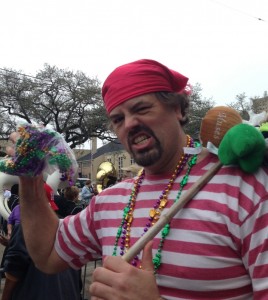
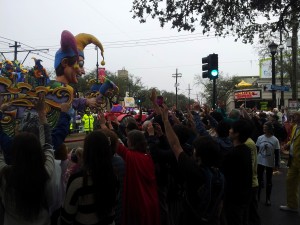
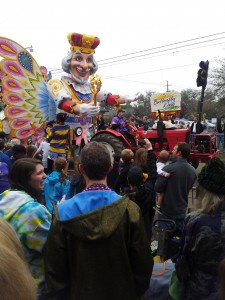
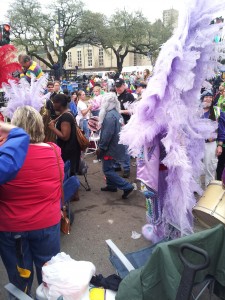
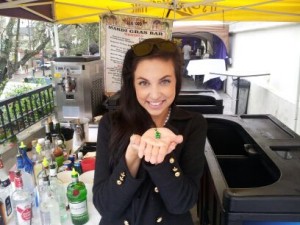
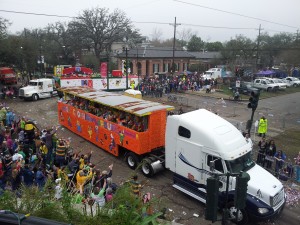

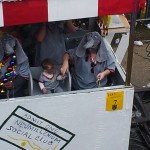
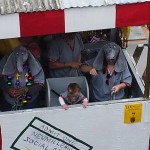
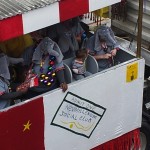
I enjoyed the description of each event. I felt as if I were there. Well written. SO proud of you.